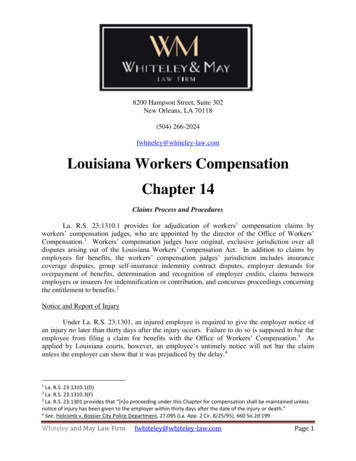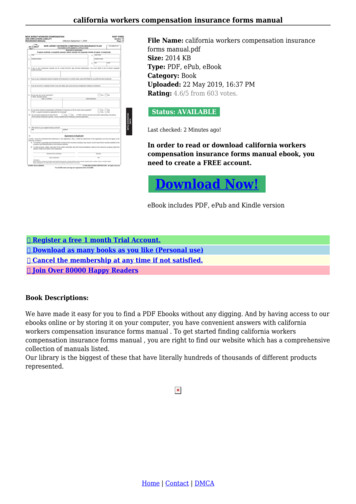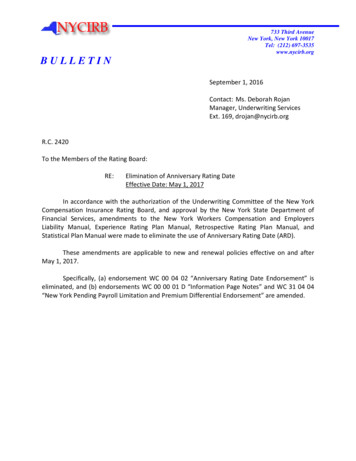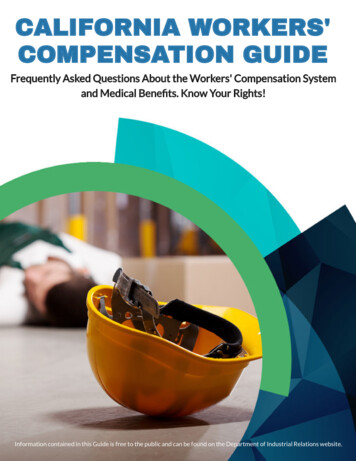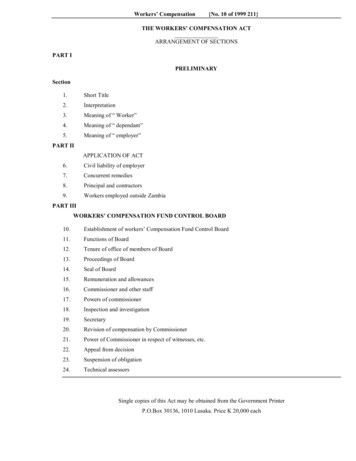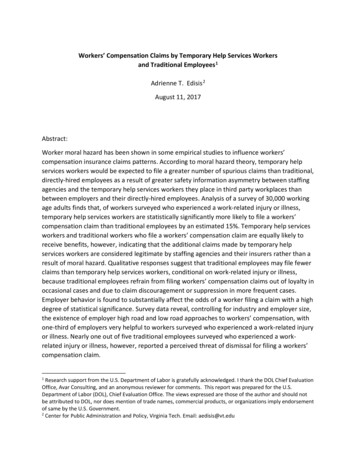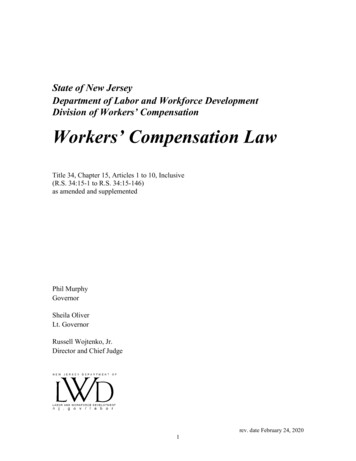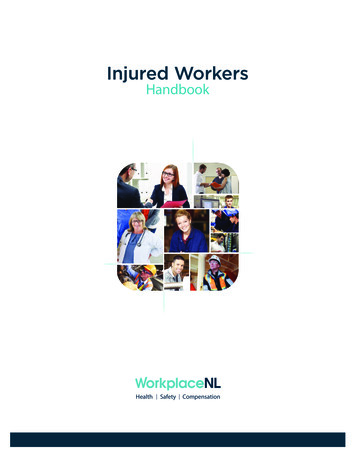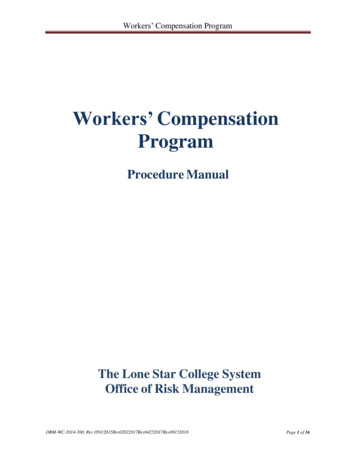
Transcription
Workers’ Compensation ProgramWorkers’ CompensationProgramProcedure ManualThe Lone Star College SystemOffice of Risk ManagementORM-WC-2014-100; Rev 05012015Rev02022017Rev04252017Rev09152018Page 1 of 16
Workers’ Compensation ProgramTable of ContentsEMERGENCY PROCEDURES & CONTACT INFORMATION. 3I.INTRODUCTION . 4II.OVERVIEW/PURPOSE . 4III.MEDICAL PAYMENTS . 5IV.CLAIM INFORMATION . 8V.DEPT PROCEDURES FOR REPORTING WORK RELATED INJURIES . 10VI.EMPLOYEE PROCEDURES FOR REPORTING WORK RELATED INJURIES . 11VII.LOST-TIME INJURIES PROCEDURES . 11VIII. NO LOST TIME INJURIES PROCEDURES. 11IX.PAYMENT OF BENEFITS . 12X.EXCEPTIONS. 12XI.NONDISCRIMINATION AGAINST CLAIMANTS . 12XII.FRAUDULENT ACTIONS . 12XIII. RETURN TO WORK PLAN . 13XIV. FORMS . 16ORM-WC-2014-100; Rev 05012015Rev02022017Rev04252017Rev09152018Page 2 of 16
Workers’ Compensation ProgramEmergency Procedures & Contact Information:A. Major Injury1. Transport the injured employee to nearest medical facility as quickly as possible. Ifnecessary, call 911 for EMS and LSC Public Safety X5911 or (281) 290-5911.B. Minor Injury1. The employee may contact the physician of his/her choice, or may go to one ofseveral occupational clinics in the area.C. Selection of Physician1. Injured employees should be aware that not every physician accepts workers’compensation benefits as a method of payment. An injured employee must seekmedical treatment from a doctor, which treats workers’ compensation patients. Theemployee may use the local telephone directory or an online search tool. Manydoctors list workers' compensation services in their ads or websites. When theemployee calls a doctor for an appointment, he/she must ask if the doctor accepts newworkers' compensation patients. The ORM has identified a few medical providers forgeneral assistance only. The employee is not limited to this list of doctors.2. An injured employee has the right to choose any physician or medical provider thatprovides workers compensation services.3. The employee may not change physicians after their initial treatment unless theyreceive approval from the LS C Workers’ Compensation carrier.D. Transportation to Medical Facility1. In a non-emergency situation, the employee will provide their own transportation forthe initial doctor visits and for any follow-up doctor appointments.E. Emergency Contact Personnel include:LSC Police Department DispatchLSC Police Department DispatchLSC Office of Risk ManagementLSC Compensation & Benefits281-290-5911 (emergency)832-813-6800 -100; Rev 05012015Rev02022017Rev04252017Rev09152018Page 3 of 16
Workers’ Compensation ProgramI. IntroductionThe Lone Star College System (LSC) Workers' Compensation Program (WCP), (See LSC PolicyManual, Section IV.E.5, Workers' Compensation Program), provides medical benefits and incomeindemnity for injuries and occupational illnesses that arise out of the course and scope ofemployment. The WCP also incorporates the procedures for accident investigation and the Returnto Work (RTW) Plan.Direct administration of the WCP is provided by the Office of Risk Management (ORM), whichcoordinates the program throughout the LSC, establishes uniform system-wide procedures,standards, and record keeping criteria, and acts as the liaison with other State of Texas agencies,including the Texas Department of Insurance, Division of Workers’ Compensation (TDIDWC).The purpose of this WCP is to establish an administrative procedure for the WCP in coordinationwith the investigation and analysis programs that are needed to promote prevention of work-relatedaccidents, injuries and illnesses. This procedure and its implementation will adhere to the policiesand guidelines of the TDIDWC, and the policy of the LSC.Workers' Compensation Insurance is regulated by the State of Texas. The TDIDWC promulgatesrules and regulations governing Workers’ Compensation. The WCP is administered by the TexasPolitical Subdivisions, Joint Self Insurance Fund (TPS) for the LSC. This WCP covers allemployees whose names appear on the payroll.This WCP will be reviewed annually by the Director of Risk Management for the LSC withrecommended revisions forwarded to the Associate Vice Chancellor, Financial Reporting andOperations.II. Overview/PurposeWhat is Workers’ Compensation Insurance?Workers' Compensation insurance is a state-regulated insurance program that provides income andmedical benefits to covered employees of LSC who suffer work related injuries, occupationaldiseases, or death in the course and scope of their employment.Injury or illness claims entitle the employee to medical benefits reasonably required at the time ofinjury and anytime thereafter to cure and relieve the effects resulting from the injury. In someinstances, financial payments will be available to offset a temporary loss of earning capacityand/or to compensate for permanent impairment due to the injury. Workers' Compensation is nothealth insurance, a benefit program, nor does it provide compensation for damage to or loss ofpersonal property.ORM-WC-2014-100; Rev 05012015; Rev 09152018Page 4 of 16
Workers’ Compensation ProgramIII. Medical BenefitsWCP provides four types of benefits.1. Medical benefits pay for the medical care necessary to treat a work related injury or illness.2. Income benefits replace a portion of any wages a worker loses because of a work-related injuryor illness.3. Death benefits replace a portion of lost family income for eligible family members of workerskilled on the job.4. Burial benefits pay some of the deceased worker’s funeral expenses.1. Medical Benefits: Medical benefits pay the medical care to treat a work-related injury orillness. The LSC workers’ compensation insurance company pays medical benefits directlyto the doctor or health care provider who treated the injured worker.Amount of medical benefits:Medical benefits pay for any medical care that is reasonable and necessary to treat a workrelated injury or illness.Medical benefits pay only for the treatment of work-related injuries and illnesses. They do notpay for the treatment of other injuries or illnesses, even if the treatment was provided at thesame time as the treatment for the work-related injury. A doctor or health care provider maynot bill the worker for treating other injuries or illnesses.When medical benefits begin and end:Injured workers may receive reasonable and necessary medical care immediately after theinjury or illness. The worker may choose any doctor who accepts workers’ compensation,however, injured employees should be aware that not every physician accepts workers’compensation benefits as a method of payment. The employee may use the local telephonedirectory or an online search tool. Many doctors list workers' compensation services in theirads or websites. When the employee calls a doctor for an appointment, he/she must ask if thedoctor accepts new workers' compensation patients. The ORM has identified a few medicalproviders for general assistance only. The employee is not limited to this list of doctors.Except in an emergency, the injured worker’s treating doctor must approve all medical carefor an injury or illness.2. Income Benefits: Income benefits replace a portion of any wages a worker loses because of awork-related injury or illness. Income benefits may not exceed the maximum weekly amountset by state law. Temporary income benefits, impairment income benefits, and lifetime incomebenefits are also subject to a minimum amount set by state law. Maximum and minimumbenefit amounts are based on the state average weekly wage.There are four types of income benefits.ORM-WC-2014-100; Rev 05012015; Rev 09152018Page 5 of 16
Workers’ Compensation Program1.2.3.4.temporary income benefits;impairment income benefits;supplemental income benefits; andlifetime income benefits.Income benefits may not exceed a maximum weekly amount.1. Temporary income benefits (TIBs): An injured worker may receive temporary incomebenefits if the injury or illness causes the worker to lose some or all income for more thanseven days. The amount of temporary income benefits equals 70 percent of the worker’s averageweekly wage immediately prior to the injury. If a worker is able to return to work under theReturn to Work (RTW) plan, the benefit is offset by wages earned while on the plan.Example: worker’s average weekly wage was 400, and an injury caused the worker tolose all of his or her income, temporary income benefits would be 280 a week:Average weekly wage 400Minus the wage after the injuryEquals 0 40070 percent of 400 (.7 x 400) equals 280If the worker earned less than 10.00 an hour before the injury, temporary incomebenefits for the first 26 weeks of payments would equal 75 percent of the difference betweenthe worker’s average weekly wage and the wage after the injury. TIBs are subject to maximumand minimum amounts.When do temporary benefits begin? An injured worker becomes eligible for temporaryincome benefits on the eighth day after the injury. Benefits are not paid for the first weekof lost wages unless disability lasts for 14 days or more.Temporary income benefits end at the earlier of the following dates:1. date the worker reaches maximum medical improvement (MMI); or2. date the worker is physically able to earn his/her pre-injury average weekly wage.2. Impairment Income Benefits (IIBs): An injured worker may receive impairment incomebenefits if the worker has a permanent impairment from a work-related injury or illness. IIBsare determined by your Impairment Rating (IR). An IR describes the degree of permanentdamage to your body as a whole. A doctor or other health care provider will assign an IR. Thisgenerally happens when an injured employee reaches Maximum Medical Improvement(MMI), which is when the employee is as well as he or she is going to be after treatment. YourIR determines if you are eligible for IIBs. If you are eligible, you get three weeks of IIBs foreach percentage of impairment. If a doctor says you have not reached MMI, you are consideredto have reached MMI 104 weeks after the date your income benefits began to accrue.Impairment income benefits equal 70 percent of the worker’s average weekly wage.Example: if a worker’s average weekly wage was 400, impairment incomebenefits would be 280 a week:ORM-WC-2014-100; Rev 05012015; Rev 09152018Page 6 of 16
Workers’ Compensation ProgramAverage weekly wage70 percent of 400 (.7 x 400) equals 400 280When do impairment benefits begin? An injured worker becomes eligible forimpairment income benefits the day after the worker reaches maximum medicalimprovement.Impairment income benefits end after the worker has received three weeks ofpayments for each percentage point of impairment rating.Example: if an injured worker has an impairment rating of six percent, the worker wouldreceive eighteen (18) weeks of impairment income benefits.3. Supplemental Income Benefits (SIBs): If you meet certain requirements, you may be eligiblefor Supplemental Income Benefits (SIBs). To get SIBs, you need to apply four times a year(every three months). If you are eligible, you will get SIBs every month.To get SIBS, you must: have an impairment rating of 15% or more; have not returned to work. Or, if you did, but are earning less than 80% of the averageweekly wage in your position because of your injury; show that you are looking for work; and not accept a lump sum payment for your injury.4. Lifetime Income Benefits: An injured worker may receive lifetime income benefits if theworker has an injury or illness that results in the loss of the hands, feet, or eyesight, or if theworker meets the conditions listed in the Texas Workers’ Compensation Act. Lifetime incomebenefits equal 75 percent of the worker’s average weekly wage, with a 3 percent increaseeach year.Example: if a worker’s average weekly wage was 400, lifetime income benefitswould be 300 a week:Average weekly wage75 percent of 400 (.75 x 400) equals 400 300Lifetime income benefits begin whenever a work-related injury or illness causes theworker to meet the conditions listed in the Texas Workers’ Compensation Act.A worker may receive lifetime income benefits for the rest of his or her life.3. Death and Burial Benefits: Death benefits replace a portion of lost family income for theeligible family members of workers killed on the job. Burial benefits pay some of the deceasedworker’s funeral expenses. A family member may receive death benefits if the family memberis the spouse, dependent child or grandchild, or another eligible family member of a workerkilled on the job. Except for the spouse and minor children, to receive death benefits, familymembers must have been dependent on the deceased worker. For more information aboutdeath benefits, contact the ORM at 832-813-6896.ORM-WC-2014-100; Rev 05012015; Rev 09152018Page 7 of 16
Workers’ Compensation ProgramIV. Claim Information1. Injured Employee: When an employee is injured, the most important thing to do is to securethe appropriate medical treatment. In an emergency, dial 911. In case of a work related injury or illness requiring non-emergency services (i.e., backpain, sprained ankle, etc.) follow the Claims Reporting Instructions. After the appropriate medical treatment has been secured, the claim is to be reported tothe ORM.2. Claims Reporting Instructions: LSC must report the following to its insurance carrier, TPS,within eight (8) days of the date: An employee misses more than one (1) day of work because of a work-related injury; An employer knows about an occupational disease or illness even if the employee has notmissed any work; or An employee dies because of a work-related injury or illness.3. Report a Claim to the ORM:Refer to the following Responsibilities of the Employee and Responsibilities of theDirect Supervisor.4.What are the responsibilities of the employee?1. Any LSC employee who suffers an accidental injury or occupational disease as a direct result of and2.3.4.5.6.7.in the course and scope of employment should immediately notify his/her direct supervisor.Failure to report the injury within 24 hours of the occurrence of the injury (or the manifestation ofthe occupational disease) may result in the denial of the claim.The employee must complete an Employee Statement of Injury, and email the completed form tohis/her Direct Supervisor within 24 hours of the occurrence of the injury (or the manifestation ofthe occupational disease).Employee should immediately contact his/her Human Resource Director for direction or guidanceregarding how LSC benefits, such as leave, FMLA, group health, disability and retirement, etc., areaffected by a workers’ compensation claim. Please refer to HR Benefits.The employee must notify the ORM of any change in income regardless of whether the incomeincreased or decreased. If the employee starts working after a period, or has been made a bona fideoffer of employment, he/she must notify the ORM, even if employment or the offer is not withinthe LSC.If you miss work due to a work related injury, you must keep the LSC informed of your work statusby providing a DWC073, Work Status Report, to your Direct Supervisor and/or the ORM aftereach doctor visit. The treating doctor’s office must provide the report to you. A DWC073, isrequired after the initial examination and if you experience a change in work status, a substantialchange in activity restrictions, or as requested by the LSC.When your treating doctor releases you to return to work, you must report to work at thebeginning of your next regularly scheduled shift. The DWC073, report from your doctorindicating a return to work date or any work-related limitations must be given to your DirectSupervisor and the ORM before you return. If you are released to return to work withrestrictions, you must work with your Direct Supervisor and the ORM to comply with anyrestrictions the physician has indicated on a work status report.If it is necessary for the employee to change treating doctors for treatment of a work-related injury,ORM-WC-2014-100; Rev 05012015; Rev 09152018Page 8 of 16
Workers’ Compensation Program8.9.10.11.the employee must complete a DWC053, Employee Request to Change Treating Doctor, andreceive written approval from TPS before making the change.It is the employee’s responsibility to keep their contact information updated within iStar and withthe ORM. If home address, work address, or contact phone number changes the employeeshould notify the Human Resources (HR) and the ORM.You must continue communicating with your Direct Supervisor and the ORM throughout anyperiod of disability unless physically unable to do so.Except in an emergency, if the employee receives medical care for a work related injury that is notby or at the direction of the treating doctor, payment of any charges associated with that care maybecome the responsibility of the employee.For more information, contact the ORM at 832-813-6896.5. What are the responsibilities of the administrators and/or supervisors with direct managerialauthority over an employee’s job duties?1. Assist the injured employee in obtaining first aid or medical care when work related accidents,injuries, or occupational illnesses occur.2. Gather all pertinent information regarding the job related injury and report it to the ORM. This willinclude witness statements, if circumstances warrant.3. Provide the employee with a completed WC Initial Examination Authorization prior to medicaltreatment. If unable to provide the WC Initial Examination Authorization to the employee, priorto medical treatment, and the employee uses their health care insurance for a work related injurycontact the ORM immediately. The employee must contact their health insurance carrier and advisethe carrier their injury is work related as health insurance carriers will only communicate withthe member employee. (Refer to HIPPA)4. Provide the employee with a completed PMOA Workers' Compensation First Prescription Fill CardVoucher.5. Maintain a detailed record of the work-related injury, even if the employee did not lose time fromwork as a result of the injury. Document all related information, such as witness accounts, possiblefraudulent behavior, and/or any concerns regarding the incident.6. Complete the DWC001, Employers' First Report of Injury or Illness, if the employee isinjured, if the injury is an occupational disease, or if the injury resulted in a work related death. TheDWC001 must be emailed or delivered to the ORM within twenty-four (24) hours after receivingnotice that the employee is injured or has contracted an occupational disease. In the event of criticalinjury or death, immediate telephone notification should be given to the ORM at 832.813.6896followed by the DWC001.7. Employee’s Direct Supervisor must complete a Supervisor’s Accident Investigation Form within24 hours of the occurrence of the injury (or the manifestation of the occupational disease), andsubmit to the ORM.8. ORM will submit a DWC006 Supplemental Report of Injury to the carrier, on behalf of theSupervisor, for each of the following:a. The injured worker returned to work in either a full or limited capacity;b. The injured worker is earning more or less than the pre-injury wage because of the injury;c. The injured worker returned, then later had additional lost time or reduced wages as a resultof the injury; ord. The injured worker resigned or was terminated from employment.9. If the injured employee misses, or is likely to miss, more than seven days of work due to the injurythe Direct Supervisor must advise the ORM. The ORM will request the DWC003, Employer'sWage Statement from Payroll and contract the appropriate SHRM to update employee records. TheDWC003 is required whenever the employing department knows (or should have known) anemployee will miss more than seven (7) consecutive or cumulative days following the injury date.This is called the waiting period and no weekly compensation payment is due for the time lost forthat period. However, if an employee is off work for more than 14 calendar days, the weekly/ORM-WC-2014-100; Rev 05012015; Rev 09152018Page 9 of 16
Workers’ Compensation Programmonthly compensation for the waiting period is paid retroactively. Instructions for completing theform are included with the DWC003 form.10. An employee who is injured on the job is not required to “formally” report the injury if his or hersupervisor (or anyone with supervisory responsibilities) has actual knowledge that the injury wassustained in the course and scope of employment. The supervisor is responsible for ensuring theinjury or exposure is reported.11. Provide the injured employee with a copy of the completed DWC001, the Injured Employee Rightsand Responsibilities (Spanish) and Ombudsman Program Notice (Spanish) under the TexasDepartment of Insurance, Division of Workers’ Compensation each time an incident is reported.V.Department Procedures for Reporting Work Related Injuries1. If the injury or exposure is an emergency, call 911 and, if possible, contact the LSC PublicSafety at 281-290-5911.2. If the injury is a non-emergency, contact the LSC Public Safety at 281-290-5911.3. Stay with the injured employee or return to the scene until help arrives.4. Do not try to move the person unless further danger exists.5. All work-related injuries or illnesses must be reported. Complete the DWC001,Employer's First Report of Injury or Illness, and forward the completed form to the ORMwithin 24 hours of the injury. This form is required whether or not there is lost time fromwork.6. If the injury/illness involves more than one day of lost time from work, please call the HRBenefits Team at 832-813-6767, for more information about FMLA and procedures tofollow.7. When the employee is medically released by the treating physician and he/she physicallyreturns to work, the DWC006, Supplemental Report of Injury must be completed within 24hours of the return to work date. Please coordinate with the ORM to ensure this isaccomplished.8. Forward all doctor’s bills and/or notes to TPS.9. An employee who is injured on the job is not required to “formally” report the injury if hisor her supervisor (or anyone with supervisory responsibilities) has actual knowledge thatthe injury was sustained in the course and scope of employment. The supervisor isresponsible for ensuring the injury or exposure is reported.10. Maintain a detailed record of the work-related injury, even if the employee did not losetime from work as a result of the injury. Document all related information, such as witnessaccounts, possible fraudulent behavior, and/or any concerns regarding the incident.11. Employers who fail to file the DWC001, Employer’s First Report of Injury or Illness, in atimely manner without good cause may result in administrative violations.12. Any unsafe condition which may have caused the injury should be corrected. If assistanceis necessary to accomplish the correction, call the ORM at 832-813-6896.13. If it is necessary for the employee to change treating doctors for treatment of a work-relatedinjury, the employee must complete a DWC053, Employee Request to Change TreatingDoctor, and receive written approval from TPS before making the change.14. The LSC ORM may, at some point while the employee’s claim is pending, exercise itsright to have the employee evaluated by a physician chosen by the TPS claims adjuster.Such an evaluation will be done to determine if the employee is disabled due to the injury.If asked to see a physician chosen by TPS, the employee will be given notice of theappointment at least ten days in advance.15. If the treating doctor has questions about the types of services he or she may perform,please contact TPS at 1-800-588-0013.ORM-WC-2014-100; Rev 05012015; Rev 09152018Page 10 of 16
Workers’ Compensation Program16. Except in an emergency, if the employee receives medical care for a work related injurythat is not by or at the direction of the treating doctor, payment of any charges associatedwith that care may become the responsibility of the employee.VI.Employee Procedures for Reporting Work Related Injuries1. Notify your supervisor immediately, no matter how minor the injury may seem. Ifnecessary, report unsafe working conditions to your supervisor or to the ORM. Your failureto report an injury within 24 hours of the incident may result in the denial of a claim.2. If you miss work due to a work related injury, you must keep the LSC informed of yourwork status by providing a DWC073, Work Status Report, to the ORM after each doctorvisit. The treating doctor’s office must provide the report to you. A DWC073 is requiredafter the initial examination and if you experience a change in work status or a substantialchange in activity restrictions, or as requested by the LSC.3. When your treating doctor releases you to return to work, you must report to work at thebeginning of your next regularly scheduled shift. The DWC073 report from your doctorindicating a return to work date or any work-related limitations must be given to the ORMbefore you return. If you are released to return to work with restrictions, you must workwith your supervisor and the ORM to comply with any restrictions the physician hasindicated on a work status report.4. You must continue communicating with your supervisor and the ORM throughout anyperiod of disability unless physically unable to do so.5. For more information, contact the ORM at 832-813-6896.VII.Lost-Time-Injuries Procedures1. Employee should immediately contact his/her Human Resource Director for direction orguidance regarding how LSC benefits, such as leave, FMLA, group health, disability andretirement, etc., are affected by a workers’ compensation claim. Please refer to HR Benefits.2. Upon recuperation of the insured employee a doctor's statement, DWC073, Work StatusReport must be presented to the ORM before the individual will be allowed to return towork. The statement should include dates of incapacitation, date released to return towork, limitations, and reason for confinement.3. When the injured employee is returning to an active status, the employing department shallimmediately contact the ORM and the campus HR Director.4. The ORM shall be notified immediately the day an injured employee returns to work inorder to discontinue the weekly Workers' Compensation payments.VIII.No Lost Time Injuries ProceduresWhen an employee is able to return to work on or before the next regularly scheduledworkday after the work related injury was sustained, it will be considered a no-lost-timeinjury and the employee will not lose any time or pay as the result of the injury. No chargewill be made to the employee's vacation or sick leave for the time lost as a result of the nolost-time injury. However, for follow-up doctor's appointments the employee is required touse sick leave, vacation or compensatory time. This also applies to an employee who hasreturned to work after a lost time injury/illness and follow-up doctor's visits are necessary.ORM-WC-2014-100; Rev 05012015; Rev 09152018Page 11 of 16
Workers’ Compensation ProgramIX.Payment of Benefits1. WCP income benefits will be paid weekly. The check will be mailed to the employee’shome address. Employees must notify the ORM when addresses change during a WCPleave of absence.2. Each check is issued with a pay period beginning and ending date. Checks cannot bereleased prior to the date and times listed above. Employees will be notified by mailregarding Holiday schedules. There are no exceptions to this policy.X.Exceptions: Texas Labor Code, Title 5, Chapter 406, Sec. 406.032:An insurance carrier is not liable for compensation if the injury:a) occurred while the employee was in a state of intoxication;b) was caused by the employee's willful attempt to injure himself or to unlawfully injure anotherperson;c) arose out of an act of a third person intended to injure the employee because of a personal reason andnot directed at the employee as an employee or because of the employment;d) arose out of voluntary participation in an off-duty recreational, social, or athletic activity that did notconstitute part of the employee's work-related duties, unless the activity is a reasonable expectancy ofor is expressly or impliedly required by the employment;e) arose out of an act of God, unless the employment exposes the employee to a greater risk of injuryfrom an act of God than ordinarily applies to the general public; orf) was caused by the employee's horseplay.XI.Nondiscrimination against Claimants1. The LSC shall n
Workers' Compensation Program ORM-WC-2014-100; Rev 05012015; Rev 09152018 Page 4 of 16 I. Introduction The Lone Star College System (LSC) Workers' Compensation Program (WCP), (See LSC Policy Manual, IV.E.5,Section Workers' Compensation Program), provides medical benefits and income indemnity for injuries and occupational illnesses that arise out of the course and scope of
